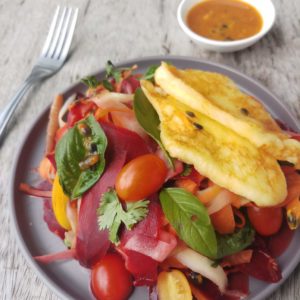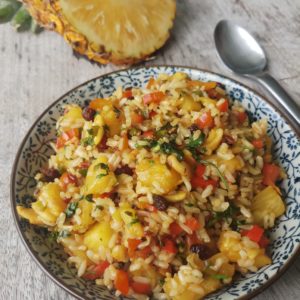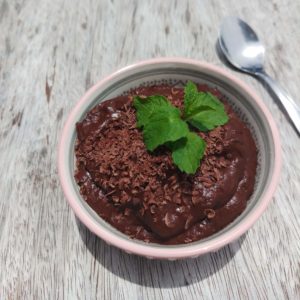Recipes

Peanut and cassava pancakes
Cassava is exclusively produced by smallholder farmers in the north, western and north-western parts of Zambia. About a third of the Zambian population depends on cassava as a major staple. Cassava flour is made from the whole cassava root that has been peeled, dried and pulverized. It is a perfect gluten-free substitute for wheat flour and a great basis for these pancakes with peanut butter.
Course Breakfast
Servings 18 pancakes
Ingredients
- 150 g cassava flour
- 270 ml milk
- 1 tsp baking powder
- 1 tbsp peanut butter
- 1 tsp vanilla essence
- 50 g honey
Additional
- Oil for baking
To serve
- 2 bananas
- Strawberries
Instructions
- Add all ingredients to a bowl and whisk well.
- Heat a little oil in a frying pan and bake the pancakes. One tablespoon of batter makes one pancake. Turn when bubbles start to appear on the surface and then bake the other side. Repeat with the rest of the batter.
- Garnish with banana slices, strawberries or your other favourite or seasonal fruit.

Haloumi salad with passion fruit dressing
This heavenly salad is to die for. The salty haloumi combines perfectly with the sweetpassion fruit dressing. I wish that all easy recipes were so tasty! So take your chancewhen passion fruits are in season, or freeze some so that you can still enjoy this saladlater in the year.
Course Salad
Servings 4
Ingredients
For the salad
- 250 g beetroot
- 250 g cherry tomatoes
- 200 g chayote
- 200 g carrot
- 200 g haloumi
- Handful basil
For the dressing
- 100 ml passion fruit juice
- 2 tbsp soya sauce
- 2 tbsp passion fruit seeds
- 1 tbsp sugar
- 1 tbsp lemon juice
Instructions
- Peel the chayote, carrot and beetroot and grate or chopthem finely. Cut the cherry tomatoes in half. Mix thevegetables and the basil leaves gently together.
- Cut the haloumi in four equal pieces. Heat a little oil in afrying pan and bake the haloumi on low to medium heatuntil it’s brown, turn and also bake the other side.
- Mix the passion fruit juice, soya sauce, passion fruitseeds, sugar and lemon juice for the passion fruitdressing.
- Arrange the vegetables on a communal plate orindividual plates. Place the haloumi on the bed ofvegetables and serve with the passion fruit dressing.

Peanut curry with butternut, sweet potato and carrot
When thinking about curry, I think about Asia. India, Thailand perhaps. But with the addition of Africa’s favourite ingredient of groundnuts this curry is becoming a dish with an African twist. After trying this recipe, you may also start thinking about Africa when thinking about curry. You may add chili, a slice of lemon and some yoghurt. Serve this curry with brown rice and/or chapati for a complete meal.
Course Main Course
Ingredients
- 400 g butternut
- 300 g carrots
- 300 g sweet potato
- 2 onions
- 2 cloves garlic
- 2 ltr vegetable bouillon
- 400 ml coconut milk
- 2 tbsp curry powder
- 1.5 tbsp peanut butter
- Handful coriander
To serve
- 80 g peanuts
Instructions
- Chop the onions, mince the garlic. Heat a little oil in a large skillet and gently bake the chopped onions and garlic until tender.
- Peel the sweet potato and butternut and cut in cubes. Slice the carrots. Add the vegetables to the onions and garlic and bake for 3-5 minutes. Stir regularly.
- Add the coconut milk, 200 ml vegetable bouillon and curry powder to the vegetable mix. Bring it to a boil and let it simmer for 25-35 minutes. Stir regularly. When the mixture becomes to dry, add more vegetable bouillon.
- When all the vegetables are tender, add the peanut butter and let it melt into the curry. Stir the coriander through the curry.
- Roast the peanuts in a dry frying pan on medium heat. Watch it carefully to make sure that the peanuts don’t burn. Garnish the curry with the peanuts.

Pineapple fried rice
Pineapple fried rice is of Thai origin, though there’s iterations of it all around the world. The most important and fresh ingredients required for this dish are all grown in Zambia. That should be more than enough reason to try out this recipe. You may not have soya sauce the cupboard in your kitchen, I would encourage you to get it as this dish may become one of your favourites.
Course Main Course
Servings 4
Ingredients
- 300 g rice
- 600 g pineapple
- 160 g raisins
- 12 spring onions
- 2 bell peppers
- 4 cloves garlic
- 80 g cashew nuts
- 3 tbsp soya sauce
- 1 tbsp vinegar
- 2 tsp curry powder
- Handful coriander
- Salt
Instructions
- Cook the rice until al dente. Drain the rice and cool completely.
- Soak the raisins for at least 20 minutes. Split the cashew nuts. Mince the garlic, peel and chop the pineapple, bell peppers and spring onions.
- Heat a little oil and fry the cashews till lightly golden. Add raisins and then garlic. Fry until it smells good.
- Add bell peppers and spring onions. Fry until the peppers are lightly cooked but crunchy.
- Add soya sauce, vinegar, salt and curry powder. Mix well.
- Add in the pineapple chunks. Sauté the mixture for about 2 minutes.
- Chop the coriander. Add the rice, little oil and then the coriander. Toss everything well and fry for 2-3 minutes.

Chocolate mousse with banana and avocado
Is chocolate mousse your guilty pleasure? With this recipe the guilt should fade rapidly. This very easy recipe does not contain any of the traditional ingredients such as egg, butter, sugar and cream. Despite that, this is a surprisingly tasty alternative. And it’s very local as well, with only raw cacao not being produced in Zambia. That should be enough reason to eat more chocolate mousse than ever. Or at least to try it once.
Course Dessert
Servings 4
Ingredients
- 2 bananas
- 2 avocados
- 80 g cacao powder
- 2 tbsp honey
To serve
- 20 g chocolate
- Fresh mint
Instructions
- Cut the banana and avocado in pieces.
- Put the bananas, avocados, cacao and honey in a food processor or (hand) blender and process until the mixture is smooth and creamy.
- Divide over small bowls and decorate with grated chocolate, mint or another topping to taste.

Pineapple cake
What a luxury to live in a country where pineapples are grown, and where it is even more economical to buy a pineapple than a bag of apples. Still Zambian pineapple growers are struggling as they are having a small market, need to compete with imported pineapples and have little opportunities to process their produce. Try to find a locally grown pineapple when embarking on baking this delicious and fresh cake.
Course Dessert
Servings 10
Ingredients
- 4 slices pineapple (1-1.5 cm)
- 190 g butter
- 190 g flour
- 170 g sugar
- 3 eggs
- 10 g baking powder
- 1 orange
- Pinch salt
Instructions
- Preheat the oven to 180°C. Cover the bottom of a round cake pan with parchment paper and grease the sides with butter.
- Peel the pineapple slices and remove the core. Divide the pineapple slices over the bottom of the tin. Leave the middle empty for easy cutting.
- Grate the skin of the orange. Mix the butter and the sugar fluffy. Mix in the eggs one by one. Add salt and orange zest. Sift the flour and add the flour and baking powder to the mixture. Mix well into a smooth batter. Divide the batter evenly over the pineapple.
- Bake 45 minutes. When ready, allow to cool down before removing the cake from the pan and turning it upside down.